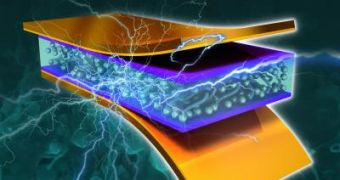Experts at the Korea Advanced Institute of Science and Technology (KAIST) say that they have created a new type of nanogenerator technology that can be manufactured at low costs. The large-area approach relies on the use of piezoelectric ceramic nanoparticles.
Piezoelectricity is a property displayed by certain kinds of crystals and ceramics, where they produce an electrical current when they are deformed mechanically. The opposite is also true – by applying an electric charge to these materials, they change their shape.
KAIST investigators were recently able to create nanoscale piezoelectric particles, which they then inserted into a new generation of nanoscale electricity generators. The team was led by Department of Materials Science and Engineering professor Keon Jae Lee.
The best part about this class of devices is that they can be powered by nonpolluting energies, including vibrations and waves (as well as any other form of mechanical energy), and produce nearly unlimited amounts of electricity. Piezoelectric effects-based nanogenerators are the next-generation energy-harvesting technology.
Over the past few years, many research groups have been focused on making them work, but high costs, size-related restriction, and the complexity of the manufacturing process have prevented their implementation at the large scale.
However, the new investigation Lee conducted managed to successfully overcome all these limitations. This was accomplished through the development of a nanogenerator that is made out of nanocomposites (composite materials at the nanoscale).
The latter are made up of a mixture of carbon nanotubes (CNT) and reduced graphene oxide, on one hand, and piezoelectric nanoparticles, on the other. All these structures are then placed into a polydimethylsiloxane (PDMS) matrix, EurekAlert reports.
“This exciting result first introduces a nanocomposite material into the self-powered energy system, and therefore it can expand the feasibility of nanogenerator in consumer electronics, ubiquitous sensor networks, and wearable clothes,” explains expert Zhong Lin Wang.
The scientist, who holds an appointment as a professor at the Georgia Institute of Technology (Georgia Tech), is the inventor of the nanogenerator.

 14 DAY TRIAL //
14 DAY TRIAL //